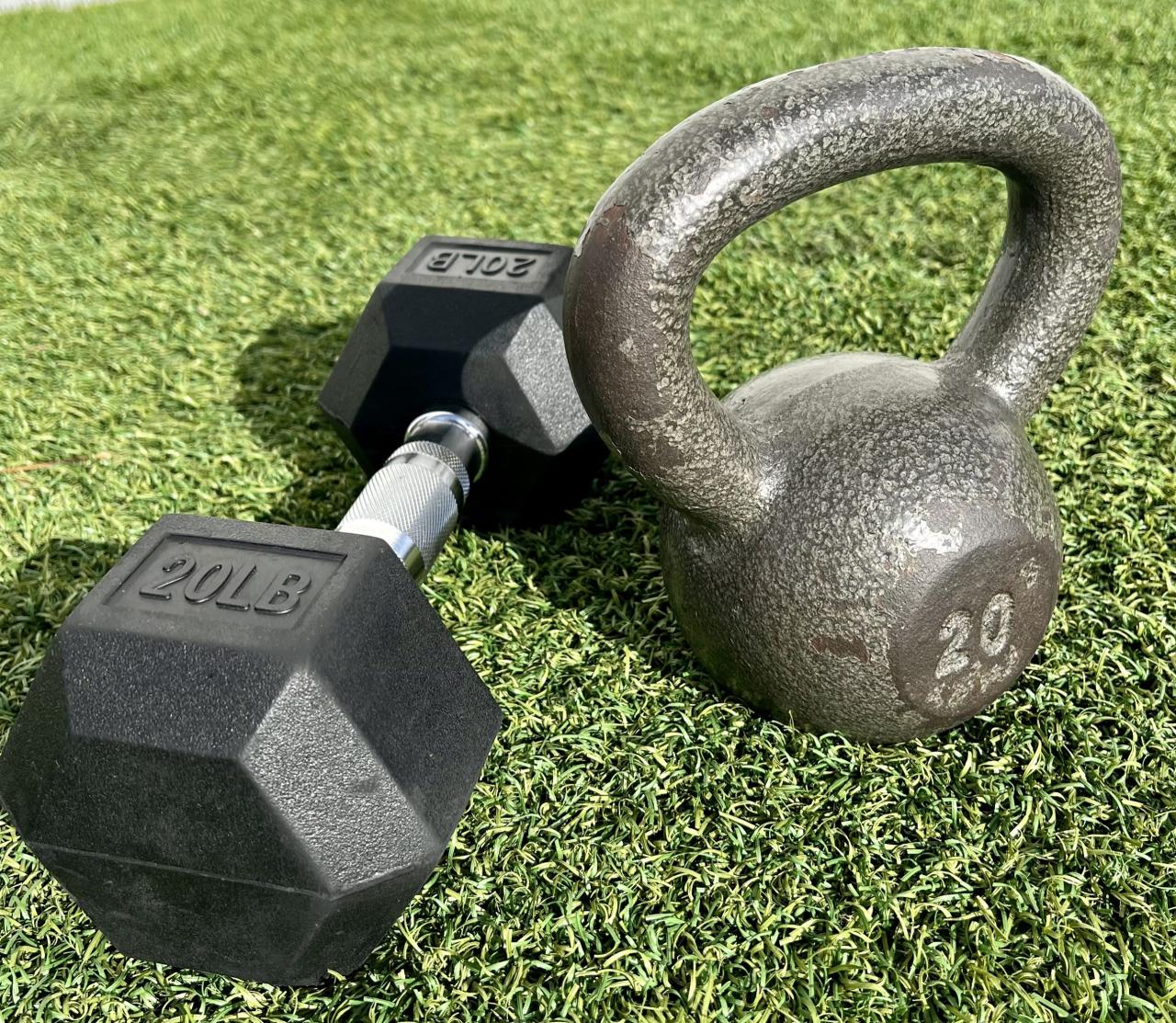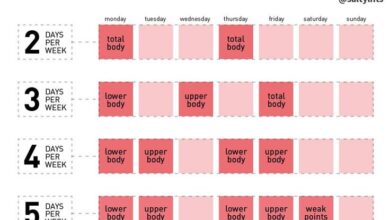
Dumbbells Versus Kettlebells Versus Bands: Which Is Right For You?
Dumbbells versus kettlebells versus bands – the age-old question of which reigns supreme in the fitness world is a debate that has raged on for years. Each of these tools offers unique advantages and disadvantages, catering to different fitness goals and preferences.
From the classic simplicity of dumbbells to the dynamic power of kettlebells and the versatility of resistance bands, the choice can be overwhelming. This guide aims to dissect the strengths and weaknesses of each, empowering you to make an informed decision that aligns with your individual fitness journey.
Whether you’re a seasoned gym-goer or just starting your fitness adventure, understanding the nuances of each tool is essential. We’ll explore the benefits and limitations of each, discuss their effectiveness for various fitness goals, and provide safety considerations to ensure a rewarding and injury-free experience.
So, buckle up and let’s delve into the world of dumbbells, kettlebells, and resistance bands!
Introduction

Dumbbells, kettlebells, and resistance bands are popular tools for strength training and conditioning. Each offers unique benefits and challenges, making them suitable for various fitness goals. This article will compare these three tools to help you determine which one is best suited for your needs.
Common Uses and Benefits
Dumbbells, kettlebells, and resistance bands offer a wide range of benefits for individuals of all fitness levels. Here’s a breakdown of their common uses and advantages:
- Dumbbells:Dumbbells are versatile tools that can be used for a wide range of exercises, including bicep curls, shoulder presses, and squats. They are effective for building muscle mass, increasing strength, and improving overall fitness.
- Kettlebells:Kettlebells are known for their unique design, which allows for a wide range of movements, including swings, snatches, and cleans. They are particularly effective for developing explosive power, improving core strength, and enhancing cardiovascular fitness.
- Resistance Bands:Resistance bands are lightweight and portable, making them ideal for home workouts or traveling. They provide constant tension throughout the exercise, engaging multiple muscle groups simultaneously. Resistance bands are particularly beneficial for improving flexibility, range of motion, and rehabilitation from injuries.
Purpose of the Comparison
This comparison aims to provide a comprehensive understanding of the advantages and disadvantages of dumbbells, kettlebells, and resistance bands. By analyzing their characteristics, effectiveness, and suitability for different fitness goals, this article will guide you in making an informed decision about which tool is best for your personal fitness journey.
Dumbbells
Dumbbells are a versatile and effective weight training tool that can be used for a wide range of exercises, from simple bicep curls to complex compound movements. They are available in a variety of weights and styles, making them suitable for people of all fitness levels.
Choosing between dumbbells, kettlebells, and resistance bands is a personal preference, just like deciding what to eat. Some days I crave the structured movements of dumbbells, while other days I feel the flow of kettlebell swings. And sometimes, I just want the versatility of resistance bands.
Finding what you enjoy is key, and the same goes for healthy eating. There are so many ways to make it work for you, from finding new recipes to learning about mindful eating – check out this article for some great tips: ways to learn to love or like eating healthy.
Just like with your workout routine, experimenting and finding what you love will keep you motivated and coming back for more.
Types of Dumbbells
Dumbbells come in two main types: fixed weight and adjustable.
- Fixed Weight Dumbbells:These are the most common type of dumbbell. They are made of a single piece of metal with a fixed weight. Fixed weight dumbbells are typically sold in sets of two, with each dumbbell having the same weight. The advantage of fixed weight dumbbells is that they are simple to use and affordable.
Dumbbells, kettlebells, and resistance bands each offer unique benefits for building strength and endurance. While I love the versatility of these home workout tools, sometimes I miss the energy and motivation of a group fitness class. However, before jumping back in, it’s important to consider the risks involved, especially with the current health climate.
What’s the risk of going back to group fitness classes is a question I’ve been pondering lately. After weighing the pros and cons, I’m leaning towards a hybrid approach – incorporating some group classes alongside my home workouts with dumbbells, kettlebells, and bands for a balanced fitness routine.
The disadvantage is that you need to purchase a dumbbell for each weight you want to use.
- Adjustable Dumbbells:Adjustable dumbbells allow you to change the weight by adding or removing plates. This makes them a more economical option than buying a separate dumbbell for each weight. Adjustable dumbbells are typically more expensive than fixed weight dumbbells, but they offer greater versatility.
Benefits of Using Dumbbells
There are many benefits to using dumbbells, including:
- Increased Muscle Activation:Dumbbells require more stabilization and control than machines, which can lead to greater muscle activation. This is because your body has to work harder to maintain balance and control the weight.
- Versatility:Dumbbells can be used for a wide variety of exercises, targeting different muscle groups. They can be used for both isolation and compound exercises.
- Ease of Use:Dumbbells are relatively easy to use and can be incorporated into many different workouts. They are also portable, so you can use them at home or at the gym.
Limitations of Dumbbells
While dumbbells offer many benefits, they also have some limitations.
- Limited Range of Motion:Dumbbells can sometimes limit the range of motion for certain exercises, especially when compared to machines. For example, a dumbbell bench press may not allow you to lower the weight as low as a machine bench press.
- Weight Restrictions:Dumbbells are typically available in a limited range of weights, which can be a problem for people who need to lift very heavy weights.
Kettlebells
Kettlebells, with their unique design and functionality, have become a popular tool for fitness enthusiasts and athletes alike. This cast-iron weight, resembling a cannonball with a handle, offers a versatile approach to strength training, combining elements of weightlifting and bodyweight exercises.
Benefits of Kettlebell Training, Dumbbells versus kettlebells versus bands
Kettlebells provide numerous benefits, including:
- Full-Body Engagement: Kettlebell exercises often involve multiple muscle groups simultaneously, promoting a holistic approach to strength development. For example, a kettlebell swing engages the glutes, hamstrings, core, and shoulders, promoting a powerful and functional movement.
- Dynamic Movements: Kettlebell exercises are dynamic and fluid, mimicking real-life movements. This enhances coordination, balance, and stability, improving overall functional fitness.
- Increased Cardiovascular Benefits: Kettlebell training can elevate your heart rate and improve cardiovascular endurance, as many exercises involve continuous movement and explosive power.
Potential Challenges of Kettlebell Training
While kettlebells offer a plethora of benefits, mastering their use requires proper technique and safety considerations.
- Proper Technique: Learning the correct form for kettlebell exercises is crucial to avoid injuries. Improper technique can lead to strain on joints and muscles. Seeking guidance from a qualified trainer or watching instructional videos can help ensure you perform exercises safely and effectively.
- Safety Considerations: Kettlebell training can be demanding. It’s important to start with lighter weights and gradually increase the load as you gain strength. Additionally, choosing a safe training environment with proper flooring and equipment is crucial.
Safety Considerations: Dumbbells Versus Kettlebells Versus Bands
Safety is paramount when engaging in any form of exercise, especially when using weights or resistance bands. Proper form and technique are crucial to maximize results while minimizing the risk of injury. This section explores the importance of safe practices for dumbbell, kettlebell, and resistance band exercises.
Potential Injuries and Prevention
Each type of equipment comes with its own set of potential injuries. Understanding these risks and implementing preventive measures is essential for a safe and enjoyable training experience.
Choosing between dumbbells, kettlebells, and resistance bands is a personal preference, but it all boils down to what exercises you enjoy and what fits your fitness goals. If you’re looking to burn calories, it’s important to consider that standing itself may not be enough, as you can read more about does standing burn enough calories to aid weight loss.
While standing burns more calories than sitting, incorporating dynamic exercises with your chosen equipment is crucial for significant calorie expenditure and achieving your weight loss goals. So, choose your weapon of choice, get moving, and see the results!
Dumbbell Injuries
- Lower Back Injuries:Improper form during exercises like dumbbell rows or deadlifts can strain the lower back. To prevent this, maintain a neutral spine and engage the core muscles throughout the movement.
- Shoulder Injuries:Incorrect technique during dumbbell presses or lateral raises can lead to shoulder impingement or rotator cuff tears. Focus on controlled movements and avoid excessive weight.
- Wrist Injuries:Holding dumbbells with a weak grip can cause wrist strain or sprains. Ensure a firm grip and use wrist straps if needed.
Kettlebell Injuries
- Wrist Injuries:Kettlebell swings, snatches, and cleans can put stress on the wrists. Proper form and grip are essential to avoid sprains or strains. Use a wrist strap if needed.
- Lower Back Injuries:Improper form during kettlebell swings or deadlifts can strain the lower back. Maintain a neutral spine and engage the core muscles throughout the movement.
- Shoulder Injuries:Kettlebell exercises like snatches and cleans can strain the shoulders. Use proper technique and avoid excessive weight.
Resistance Band Injuries
- Wrist Injuries:Resistance bands can cause wrist strain if not used correctly. Use a firm grip and avoid sudden movements.
- Shoulder Injuries:Incorrect technique during resistance band exercises can lead to shoulder impingement or rotator cuff tears. Avoid overstretching and maintain a controlled movement.
- Lower Back Injuries:Resistance band exercises that involve twisting or bending can strain the lower back. Maintain a neutral spine and engage the core muscles throughout the movement.
Safe Training Practices
Here are some general recommendations for safe and effective training practices:
- Warm-up Properly:Always warm up before starting any workout to prepare your muscles and joints for exercise. This can include light cardio and dynamic stretching.
- Start with a Lighter Weight:Begin with a weight that allows you to maintain proper form and gradually increase the weight as you get stronger.
- Focus on Technique:Prioritize proper form over weight. Correct technique is essential to prevent injuries and maximize results.
- Listen to Your Body:Pay attention to any pain or discomfort. Stop the exercise immediately if you experience any pain.
- Seek Professional Guidance:Consult with a certified personal trainer or fitness professional for personalized advice and guidance.
Conclusion
Choosing the right fitness equipment can be overwhelming, especially when considering dumbbells, kettlebells, and resistance bands. Each option offers unique benefits and drawbacks, making it essential to understand their strengths and weaknesses. This article explored the benefits and drawbacks of each equipment type, providing insights into their effectiveness for various fitness goals.
Choosing the Best Equipment
Choosing the best equipment depends on your fitness goals, preferences, and budget. Here are some factors to consider:
- Fitness Goals:If you’re aiming for strength training, dumbbells and kettlebells are excellent choices. Resistance bands are more suitable for improving flexibility, mobility, and muscle activation.
- Experience Level:Beginners may find resistance bands easier to use due to their versatility and lower risk of injury. Experienced lifters can benefit from the challenges offered by dumbbells and kettlebells.
- Space and Budget:Resistance bands are compact and affordable, making them ideal for home workouts. Dumbbells and kettlebells require more space and can be expensive, especially if you’re looking for a comprehensive set.
- Injury Prevention:Resistance bands offer a lower impact workout, making them suitable for individuals with joint pain or injuries. Dumbbells and kettlebells can be more demanding on the joints, especially if improper form is used.
Ultimately, the best equipment is the one you’ll use consistently. Experiment with each option and find what works best for you.
End of Discussion

Ultimately, the choice between dumbbells, kettlebells, and resistance bands boils down to your individual needs and preferences. Each tool offers a unique set of benefits, and the best choice will depend on your fitness goals, workout style, and experience level.
Remember, the key to success lies in finding the right tool that excites you and keeps you motivated on your fitness journey. So, explore the options, experiment with different exercises, and discover the tool that unlocks your full potential.





